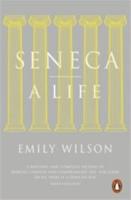
Allen Lane (2015) h/b 253pp £25 (ISBN 9781846146374)
In this brilliant introduction to the man, his times, his thought and his remarkable corpus of writings, we follow Seneca (c. 4-65 BC) from his birthplace in Corduba in Spain to Rome for his education, to Egypt for his recuperation from a lung infection, and back to Rome (with an interval in exile in Corsica) in the context of the social, political, economic and intellectual worlds he inhabited. But the bulk of the book is, of course, about Seneca himself—his soul, and his struggles with its priorities, especially in his role as adviser to the infamous Nero.
As history’s most recognisable Stoic, he knew his soul to be at one with the spirit of the universe; that this rational element was sustained by decisions which led to virtuous outcomes; that worldly enticements might be preferable to unworldly ones, but were, nevertheless, of utter indifference to the philosopher; and that a virtuous death was to be sought rather than shunned. So we must ask—amongst many other questions—was he a hypocrite? After all, he acquired almost unimaginable wealth, much of it from Nero, which was well beyond the possibility of consumption. So even if it was a matter of indifference to him, it was utterly irrational, and non-Stoical, to keep what could not be consumed.
Then there were the decisions he made, under pressure from Nero, such as to be involved with the deaths of Nero’s mother Agrippina and Britannicus, son of the previous emperor Claudius. Perhaps these were offers he couldn’t refuse, but he did have an alternative, of which he was never afraid to preach, and which might provide the perfect finishing touch to such a Stoic—suicide. But that only came later, when his trusted friend and ally Burrus, head of the Praetorian Guard, was killed. Seneca knew himself to be increasingly under threat inside an unutterably corrupt court, within which any manifestation of virtue could be destructive. Unfortunately for him, he didn’t have the chance to choose suicide—Nero chose it for him, and the remaining accounts of him hopelessly hacking away at arteries and taking hemlock, surrounded, like Socrates, by an audience for his dying words, do him no favours at all.
W. talks in Freudian terms, anachronistically, but persuasively, of Seneca’s ‘neurotic fear’ and ‘pathological manifestations of obscurely motivated anxiety’ (obscurely motivated? He was Nero’s advisor!) from which he sought relief in philosophy, family and friends. And, perhaps most cruelly for him, his final Stoic gesture, which should have provided him ultimate relief, was in vain. He survived the knife and the poison, and died in the mists of a hot, steamy bath.
Yet Seneca has never gone away completely: at key points of Western history, he is there, when events turn us towards self-examination and the question of what we should be doing with our lives. Get some copies in.
Adrian Spooner
